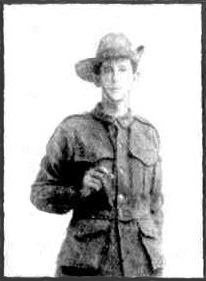Arthur Edward Bingham
From Our Contribution
 Western Mail 7 Sep 1917 page 19 | |
| Personal Information | |
|---|---|
| Date of Birth | Not known |
| Place of Birth | Williams, Western Australia |
| Death | 16 Sep 1969 |
| Place of Death | Floreat Park, Western Australia |
| Age at Enlistment | 18 years, 7 months |
| Description | 5' 1 3/4 " (1.57m) tall; weight 170 lbs (77.1 Kg); sallow complexion, brown eyes, black hair |
| Occupation | farmer |
| Religion | Church of England |
| Address | NOK Prospect road, Armadale, Western Australia |
| Next of Kin | Father Mr William Henry Bingham |
| Military Information | |
| Reg Number | 5338 |
| Date of Enlistment | 17 Feb 1916 |
| Rank | Private |
| Unit/Formation | 16th Battalion, 17th Reinforcements |
| Date of Embarkation | 17 Apr 1916 - 17 May 1916 |
| Ship Embarked On | HMAT A60 Aeneas |
| Date of Return | 16 Feb 1918 - 8 Apr 1918 |
| Ship Returned On | SS Llanstephan Castle |
| Fate |
Wounded in Action 11 Apr 1917 at 1st Bullecourt Returned to Australia |
| Monument |
Armadale (Armadale panel) Armadale Congregational Church Honour Board |
| Medals |
British War Medal Victory Medal |
Pre War
War Service
Joined with brother 5339 Austin Henry (Paddy) Bingham
Initially allocated to the 11th reinforcement draft for the 28th Battalion, a month after entering Blackboy Hill camp he was reallocated to the 17th draft for the 16th Battalion. Two months after entering Blackboy Hill camp he was shipped to Egypt and then on to France aboard the HMT Ionian, arriving in Marseilles on 14 Jun 1916.
Prior to joining his Battalion, Arthur spent several weeks during August 1916 ill in hospital in France with German measles.
While he joined the 16th Battalion on 25 Aug 1916, he again received medical attention with 4th Australian Field Ambulance and the 41st Division Rest Station for scabies from 13 Oct till 9 Nov 1916.
Arthur was wounded during the 1st Battle for Bullecourt on 11 Apr 1917, receiving GSWs to both legs - his left leg "blown off 4 inches below the knee" and right leg wounded in three places, along with wounds in his chest and little finger. Treated at 13th Australian Field Ambulance and then the 49th Casualty Clearing Station, he was sent to the 9th General Hospital in Rouen.
Shortly after, he was transferred to the 1st Birmingham War Hospital where the "amputation" occurred, along with a finger from his left hand. The amputation was probably a neat termination of the already missing lower leg.
On 7 Jul 1917 he moved to the 2nd Australian Auxiliary Hospital (AAH) in Southall. The wound did not heal until December 1917 as he required four more operations to drain his stump and trim the little finger. Meanwhile the wound to his chest was also very slow to heal. During his time with the 2nd AAH, Arthur was granted two periods of furlough before preparing for the return to Australia.
Discharged 5th Military District on 28 Aug 1918.
"Enlisted 15th February, 1916; sailed with the 17th Reinforcements of the 16th Battalion on 17th April to Egypt. Went with the troops to France and afterwards to Belgium."[1]
Casualty List 295 Arthur was listed as wounded in action[2]
Post War
In 1919 he married Hilda Whitehurst. Hilda died 2 Feb 1993 aged 97 in West Perth. No descendants?
In 1925 they were living at 34 Teague street in Victoria Park, with Arthur working as a harness maker, but in 1931 he was a railway employee living at 10 Clyde street in Maylands. 1943 - 1949 at 47 Orrel avenue, Wembley Park; 1954 at 38 Williams road, Kalamunda, a pensioner; 1958 - 1968 at 22 Kinross crescent Floreat Park.
References
- ↑ "The Drill of the Foot-Hills" (PDF) (1917). Western Australia. Feb–Mar 1917. p. 6. Retrieved 16 May 2017 – via State Library of Western Australia.
- ↑ "WESTERN AUSTRALIA.". The West Australian. XXXIII, (4,715). Western Australia. 14 May 1917. p. 8. Retrieved 25 May 2017 – via National Library of Australia.